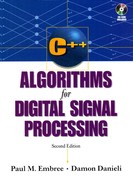Book Description
Bring the power and flexibility of C++ to all your DSP applications
The multimedia revolution has created hundreds of new uses for Digital Signal Processing, but most software guides have continued to focus on outdated languages such as FORTRAN and Pascal for managing new applications. Now C++ Algorithms for Digital Signal Processing applies object-oriented techniques to this growing field with software you can implement on your desktop PC. C++ Algorithms for Digital Signal Processing's programming methods can be used for applications as diverse as:
Digital audio and video
Speech and image processing
Digital communications
Radar, sonar, and ultrasound signal processing
Complete coverage is provided, including:
Overviews of DSP and C++
Hands-on study with dozens of exercises
Extensive library of customizable source code
Import and Export of Microsoft WAV and Matlab data files
Multimedia professionals, managers, and even advanced hobbyists will appreciate C++ Algorithms for Digital Signal Processing as much as students, engineers, and programmers. It's the ideal bridge between programming and signal processing, and a valuable reference for experts in either field.
Source code for all of the DSP programs and DSP data associated with the examples discussed in this book and Appendix B and the file README.TXT which provide more information about how to compile and run the programs can be downloaded from www.informit.com/title/9780131791442
Table of Contents
- Copyright
- Preface
- List of Key Symbols
- 1. Digital Signal Processing Fundamentals
- 1.1. Sequences
- 1.2. Linear Time Invariant Operators
- 1.3. Digital Filters
- 1.4. The Discrete Fourier Transform
- 1.5. Nonlinear Operators
- 1.6. Linear Algebra: Matrices and Vectors
- 1.7. Probability and Random Processes
- 1.8. Adaptive Filters and Systems
- 1.9. Two-Dimensional Signal Processing
- 1.10. References
- 2. Programming Fundamentals
- 2.1. The Elements of DSP Programming
- 2.2. Variables and Data Types
- 2.3. Operators
- 2.4. Program Control
- 2.5. Functions
- 2.6. Macros and the C Preprocessor
- 2.7. Pointers, Arrays, and References
- 2.8. Structures
- 2.9. Classes
- 2.10. Input and Output
- 2.11. Common C++ Programming Pitfalls
- 2.12. Comments on Programming Style
- 2.13. References
- 3. User Interface and Disk Storage Routines
- 4. Filtering Routines
- 4.1. Digital Versus Analog Filters
- 4.2. FIR Filters
- 4.3. IIR Filters
- 4.4. Real-Time Filters
- 4.5. Interpolation and Decimation
- 4.6. Complex Filters
- 4.7. Filtering to Remove Noise
- 4.8. Nonlinear Filtering
- 4.9. Oscillators and Waveform Synthesis
- 4.10. Adaptive Filtering and Modeling of Signals
- 4.11. Exercises
- 4.12. References
- 5. Discrete Fourier Transform Routines
- 5.1. The Discrete Fourier Transform Routine
- 5.2. The Inverse Discrete Fourier Transform
- 5.3. The Fast Fourier Transform Routine
- 5.4. The Inverse FFT Routine
- 5.5. Windowing Routines
- 5.6. Magnitude, Phase, and Logarithmic Displays
- 5.7. Optimizing the FFT for Real Input Sequences
- 5.8. Fourier Transform Examples
- 5.9. Fast Convolution Using the FFT
- 5.10. Power Spectral Estimation
- 5.11. Interpolation Using the Fourier Transform
- 5.12. Exercises
- 5.13. References
- 6. Matrix and Vector Routines
- 7. Image Processing Routines
- A. Standard C++ Class Library
- A.1. Math Functions
- A.2. Character String Functions
- A.2.1. Convert String to Double-precision Number: strtod, atof
- A.2.2. Convert String to Integer: strtol, atol, atoi
- A.2.3. Number to String Conversion: ecvt, fcvt, gcvt
- A.2.4. String Manipulation Functions: strcat, strncat, strcmp, strncmp, strcpy, strncpy, strlen, strchr, strrchr, strpbrk, strspn, strcspn, strtok
- A.3. Memory Allocation Operators
- A.4. Standard Input/Output Classes
- A.4.1. Get a Character from a Stream: get
- A.4.2. Get a String from a Stream: getline
- A.4.3. Get a Block of data from a Stream: read
- A.4.4. Get a Class from a Stream: operator >>
- A.4.5. Send a Character to a Stream: put
- A.4.6. Send a String or Block of data to a Stream: write
- A.4.7. Open a File: open
- A.4.8. Determine the Position of a File Pointer: tellg, tellp
- A.4.9. Resposition a File Pointer: seekg, seekp
- A.4.10. Close a File: close
- A.4.11. Formatted Output Conversion: printf, sprintf
- A.4.12. Formatted Input Conversion: scanf, sscanf
- A.5. Other Standard Functions
- B. DSP Function Library and Programs
- License Agreement and Limited Warranty
- About the CD-ROM
